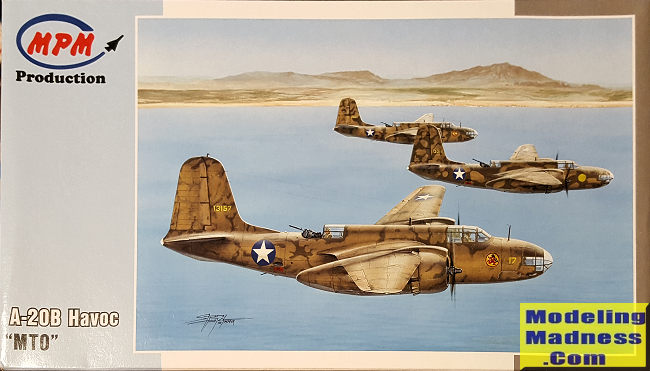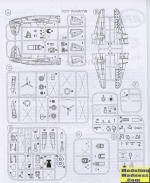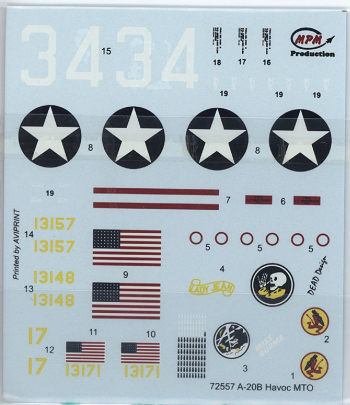
MPM 1/72 A-20B Havoc "MTO"
| KIT #: | 72557 |
| PRICE: | $42.00 |
| DECALS: | Three options |
| REVIEWER: | Scott Van Aken |
| NOTES: |

| HISTORY |
The Douglas DB-7/A-20 Havoc was the most-produced attack bomber during World War II. A total of 7,477 DB-7/A-20s were built, most at Douglas, although 380 were built at the Boeing plant in Seattle, Wash. The Havoc was a mid-wing, twin-engine, three-place medium bomber that earned a reputation for getting its crews home, even when both crew and aircraft suffered crippling blows. It was called the "Boston" when it was built for England's Royal Air Force.
It entered production when, despite official neutrality in 1938, there was little doubt in the United States that the country should support its allies, Britain and France. The French saw the secret bomber project at the Douglas Santa Monica, Calif., facility and ordered the first 107 DB-7s; they were to be delivered to the French Purchasing Commission at Santa Monica starting in October, with deliveries made by ship to Casablanca. The French then ordered another 270 DB-7s. Before the fall of France in June 1940, half had been accepted, but many were still en route. Sixteen had been diverted to Belgium's Aviation Militaire.
The United Kingdom took over 162 of the DB-7s intended for France as well as Belgium, which also had fallen. By the time the United States entered World War II at the end of 1941, British Havocs and Bostons had already performed well for most of the year against German targets in North Africa and Southern Europe. The U.S. Army Air Corps designated the plane the A-20 Havoc, and it served in every theater of the war.
More than half of the DB-7/A-20s built went into service in other countries, predominantly the Soviet Union. Versions also included the F-3 photo reconnaissance aircraft and the P-70 night fighter.
The A-20B, and subject of this kit, was the second production version following the DB-7/A-20A and had a larger vertical fin and uprated engines as well as other improvements. These were widely used by the USAAF and Commonwealth air arms during the war in North Africa.
| THE KIT |
 The breakdown of the kit is such that it is obvious
this is one of several other boxings. Indeed, this kit uses about 60% of the
parts that were in the A-20G that I previewed about ten years back. There are
major differences including the fuselage halves, the clear sprue and an entirely
new sprue that includes bits for the non-turreted A-20. It appears that there
are bits for the P-70A in this box as the radar antenna are included along with
a non-glass nose.
The breakdown of the kit is such that it is obvious
this is one of several other boxings. Indeed, this kit uses about 60% of the
parts that were in the A-20G that I previewed about ten years back. There are
major differences including the fuselage halves, the clear sprue and an entirely
new sprue that includes bits for the non-turreted A-20. It appears that there
are bits for the P-70A in this box as the radar antenna are included along with
a non-glass nose.
Much of the interior is similar in all the boxings. Starting in the cockpit, we have a nicely done section with raised panel detail on the instrument panel, a set of rudder pedals, control wheel and a rather generic seat without belts. MPM did not supply a life raft for the compartment behind the pilot, and I think this was pretty standard stuff for the A-20. There are inserts for the sides of the cockpit for panels. One will need to be trimmed to fit and that is shown. There are also a lot of boxes for the gunner in back so I have to assume he was also the radio operator. Since this is a glass nose, you'll have to put the weight behind the cockpit section as there is very little room under the bombardier's section. You could also add some behind the engines.
Engines are built up out of a pair of rather generic looking cylinder banks with a gear housing fitting on the front. The nacelles have some interior detailing to them for the supercharger coolant scoops. The large intake scoops atop the wings are the only parts on my kit that showed any sort of sink marks. Easy to fix, but it will also fill in some detail. Early A-20s had a single exhaust collector so no requirement for the tiny triangular exhaust fitted to later planes.
Landing
gear are quite scale appearing and are a rather complex assembly. One will have
to take care while con structing this section. Once the gear are attached the
lower wing, the nacelles are glued on. This is after the wings are glued in
place. Well, I'm sure most of us will alter that construction sequence some to
be sure to get all the engine and nacelle seams properly taken care of. Clear
bits are particularly nicely done with
the upper hatch section molded separately to show the bare life raft compartment
and the cockpit. I also found it interesting that there is no pretense for
allowing spinning props. One just glues them in place in the final construction
assembly!
structing this section. Once the gear are attached the
lower wing, the nacelles are glued on. This is after the wings are glued in
place. Well, I'm sure most of us will alter that construction sequence some to
be sure to get all the engine and nacelle seams properly taken care of. Clear
bits are particularly nicely done with
the upper hatch section molded separately to show the bare life raft compartment
and the cockpit. I also found it interesting that there is no pretense for
allowing spinning props. One just glues them in place in the final construction
assembly!
Instructions are well drawn with a few detail drawings as well. Gunze paints are recommended though generic color references are provided. The Aviprint decals are very nicely done and give markings for three USAAF planes that are all OD over Neutral Grey. The box art option from 84 BS/47 BG is heavily overpainted with Sand and it may be easier to paint the upper surface sand first then add the squiggles of OD. The other two are also from the 47th BG in 1943 and have medium green splotches along the edges of all the upper flight surfaces.
| CONCLUSIONS |
So there you have it. A proper, modern mold 1/72 A-20B Havoc. Sure, the ancient Revell kit makes into a nice model, but the detail (and fiddlyness) leven on this one is much higher. For sure, it will make into a superb model.
| REFERENCES |
http://en.wikipedia.org
www.boeing.com
May 2018 Copyright ModelingMadness.com. All rights reserved. If you would like your product reviewed fairly and quickly, please
contact
me or see other details in the
Note to
Contributors.